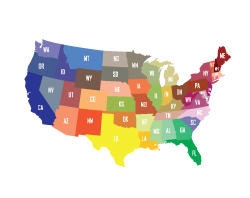Clients seeking to travel to Canada with criminal convictions from the U.S. (or any other country, for that matter) require unique advice.º Living in a state next to Canada means that we must be aware that many of our clients are likely to seek entry into Canada, and be extremely disappointed if they are turned back at the border. Because so many of our clients take entry into Canada for granted, it is important to consider several issues relating to entry to Canada. These include who can enter Canada, who can be excluded from Canada, how to overcome exclusion from Canada, and whether a client who is ineligible for rehabilitation can nonetheless seek entry.
Who Can’t Enter Canada?
Most people assume, without question, that just about anyone can enter Canada. This is not true. The Canadian Customs and Immigration Officers have ultimate authority to permit and deny anyone entry to Canada. No one has an automatic right to enter Canada. However, most people if they have no criminal record are allowed entry. What if you have a criminal conviction?
Convictions and Canadian Law
To begin, in Canada a DUI is a felony and therefore an excludable offense under the Immigration Act. A DUI is an indictable offense in Canada that may be punished by imprisonment for up to a 5-year term.
Anyone with a conviction in the United States that is treated as a felony or indictable offense in Canada is excludable from Canada, but even if the offense is not a felony or indictable offense in Canada, Customs and Immigration Officers have ultimate authority to permit and deny entry to Canada.
Almost all convictions (including DUI, DWI, reckless driving, negligent driving, misdemeanor drug possession, all felonies, domestic violence (assault IV), shoplifting, theft, etc) can make a person inadmissible to Canada, regardless of when they occurred. For this reason, it is not recommended that persons with past convictions attempt to enter Canada without first obtaining the necessary documents. It is always the final decision of officers at ports of entry to decide whether a person should be allowed into Canada.
Legal Context and Discretion
The Seattle Times explained the vortex travelers enter when they try to get into Canada. As the article makes clear, entry is frequently denied in spite of signs warning travelers before they get on a plane.
The reason for this exclusion is contained in Canadian law. The Canadian Immigration Act, in § 19; states:
(2) No immigrant and, except as provided in subsection (3), no visitor shall be granted admission if the immigrant or visitor is a member of any of the following classes:
(a) Persons convicted in Canada of an indictable offense, or of an offense prosecutable by indictment, or punishable on summary conviction under any Act of Parliament by a maximum term of imprisonment of fewer than ten years, excluding offenses designated as contraventions under the Contraventions Act. (a.1) persons who authorities reasonably believe (i) have been convicted outside Canada of an offense that, if committed in Canada, would constitute an offense punishable by indictment under any Act of Parliament by a maximum term of imprisonment of fewer than ten years, or (ii) have committed an act or omission outside Canada that constitutes an offense under the laws of the place where the act or omission occurred, and that, if committed in Canada, would constitute an offense punishable by indictment under any Act of Parliament by a maximum term of imprisonment of fewer than ten years, except persons who have satisfied the Minister that they have rehabilitated themselves and that at least five years have elapsed since completing any sentence imposed for the offense or since committing the act or omission, as the case may be.
Discretionary Entry
Later, in § 3 of the Immigration Act, there is a provision that permits discretionary entry:
A senior immigration officer or an adjudicator can grant entry to a person who belongs to an inadmissible class, subject to the terms and conditions they deem appropriate, for a period not exceeding thirty days. If the officer or adjudicator believes that the purpose of entry justifies admission, they can allow it.
Again, the Canadian Consulate emphasizes that this entry is discretionary, and in the post 9/11 aftermath, officers are more typically exercising their discretion to deny entry than to grant entry. Even if a Canadian Minister (I’m not sure which minister) has approved a client’s entry, the border person can still reject the person.
Permit Process
Finally, there is a permit process that requires a prior application and may permit an otherwise excludable person to enter Canada. The consulate general’s website provides information on the permit, which allows a visit of up to 30 days. Once approved, it may be re-approved if the application is made within a 3-year period. The next section discusses this process in detail.
Overcoming Exclusion from Canada.
There are several ways individuals can overcome criminal inadmissibility, but the short answer you must give your client is that there is no short and easy way to do it. These include:
- Deemed rehabilitation at a Canadian port of entry
- Streamlined rehabilitation at a Canadian port of entry
- Approval of rehabilitation through a Canadian Consulate in the United States
- A Temporary Resident Permit through a Canadian Consulate in the United States
1. Deemed Rehabilitation.
Eligibility for Deemed Rehabilitation at a Port of Entry
Persons are eligible to apply for deemed rehabilitation at a port of entry if the following are true:
- There was only one conviction in total
- At least ten years have passed since completing all sentences for the conviction (payment of all fees, completion of jail time, restitution paid, etc.)
- The conviction is not considered serious criminality in Canada (most felony convictions in the United States are equivalent to serious criminality in Canada)
- The conviction did not involve any serious property damage, physical harm to any person, or any type of weapon
Representation by U.S. Lawyers
U.S. lawyers should note that Canada only recognizes three types of paid representatives named on Canadian immigration forms:
- Immigration consultants who are members in good standing of the Canadian Society of Immigration Consultants (CSIC)
- Lawyers who are members in good standing of a Canadian provincial or territorial law society and students-at-law under their supervision
- Notaries who are members in good standing of the Chambre des notaires du Québec and students-at-law under their supervision
Submission of an immigration form and designation of a U.S. lawyer who is not a member of one of these three groups will result in Canada returning the application.
2. Streamlined Rehabilitation.
Persons are eligible to apply for streamlined rehabilitation at a port of entry if the following are true:
- There were two or fewer convictions in total;
- At least five years have elapsed since all of the sentences for the conviction(s) were completed (payment of all fees, jail time completed, restitution paid, etc);
- The convictions would not be considered serious criminality in Canada (most felony convictions in the United States are equivalent to serious criminality in Canada); and
- The convictions did not involve any serious property damage, physical harm to any person, or any type of weapon.
3. Deemed & Streamlined Rehabilitation Applications.
Deemed rehabilitation and streamlined rehabilitation applications are processed at Canadian ports of entry. Submitting an application for rehabilitation does not guarantee that the request will be approved. Should your client wish to apply for either, the client must bring the following documents to a port of entry during regular business hours (Monday – Friday between 8 am and 5 pm):
- A United States passport or birth certificate (with photo identification);
- A copy of court documents for each conviction, and proof that all sentences were completed;
- A recent FBI identification record;
- Recent police certificates from the state where the conviction(s) occurred, and from any state where a person has lived for six (6) months or longer in the last 10 years; and
- A fee is involved for the streamlined rehabilitation process, equivalent to $200.00 Canadian. There is no fee for deemed rehabilitation.
4. Approval of Rehabilitation.
If more than 5 years have passed since completing all sentences related to the convictions, but you are not eligible for rehabilitation at a port of entry due to the nature or number of convictions, you can apply for approval of rehabilitation through a Canadian Consulate in the United States. You must provide the same documents required for port of entry rehabilitation, along with a completed Application for Criminal Rehabilitation (Citizenship & Immigration Canada Form IMM 1444). Five Canadian Consulates in the U.S. process criminal applications – Buffalo, NW, New York, NY, Detroit, MI, Los Angeles, CA, and Seattle, WA. Again, the decision to approve rehabilitation is discretionary, so there is no certainty in obtaining admission to Canada. In the situation where a person is ineligible for rehabilitation because of the nature or number of convictions, employment of competent Canadian immigration counsel may facilitate approval of the application.
5. Temporary Resident Permit.
If a person is not eligible for deemed, streamlined, or approved rehabilitation, the only option remaining (short of a pardon or executive action) is to apply for a temporary resident permit. This is a process where a person requests special permission to enter or remain in Canada.
A person seeking a temporary resident permit submits the documents required for deemed or streamlined rehabilitation as well as a completed Application for Criminal Rehabilitation, except that the applicant does not check the box in § A(1) indicating Application for Approval of Rehabilitation, but instead checks the box in § A (2) indicating For Information Only.
As poignantly noted on the Citizenship & Immigration Canada website, the Customs and Immigration officer will review the Application form, look at the nature of the offenses, the number of offenses, when the offenses happened, and the applicant’s current situation, and then the officer will:
At Canadian visa offices outside of Canada:
- advise that they do not recommend that you travel to Canada; or,
- advise that you could apply for special permission (temporary resident’s permit) to enter Canada.
At Ports of Entry (airport, marine, or land)
(Contact your nearest Canadian visa office before traveling into Canada.)
- advise that you will not be allowed to enter Canada and ask you to return immediately to your country of departure;
- take enforcement action (arrest, detention, and/or removal); or,
- advise that you could apply for special permission (temporary resident’s permit) to enter Canada.
In Canada
- ask that you leave Canada voluntarily;
- take enforcement action (arrest, detention, and/or removal from Canada); or
- advise that you could apply for special permission (temporary resident’s permit) to remain in Canada.
The safest course of conduct is to make an application for and obtain approval of, a Temporary Resident Permit at a Canadian consulate in the U.S. prior to attempting entry to Canada. The website indicates that Approval of Rehabilitation and Temporary Resident Permits take a minimum of six (6) months to process in the Seattle office; a telephone conversation last month indicated the time in Seattle is much closer to one year. Clients seeking quicker decisions should direct their applications to the Canadian Consulates in Detroit and Buffalo.
Failure to timely seek a Temporary Resident Permit can result in disastrous consequences. Customs and Immigration in Toronto stopped a client who failed to seek a Temporary Resident Permit. They detained him and returned him to Denver on the next flight home the following morning. He missed closing a multi-million dollar sale and lost his job as a vice-president in the cellular phone industry. Canadian officials stopped and questioned another client who failed to seek a Temporary Resident Permit but permitted her to enter Canada for business. They advised her that she might not always be so fortunate.
Once a Temporary Resident Permit is granted, it must be updated every 6 months to 1 year. It is not permanent. There are significant non-refundable processing fees associated with Temporary Resident Permits, and not surprisingly, higher fees correspond to cases involving more serious criminality.
6. Processing Problems.
The most frequent problem is inadequate or incomplete documentation. Although court documents may be difficult to obtain, Canada typically requires them for review. Providing proof of completed sentences is crucial. This proof includes a letter stating that a person’s civil rights have been restored, a letter from a probation officer confirming the successful completion of all sentences, or proof of the final payment of a fine showing a zero balance. If the court has destroyed court documents or proof of completed sentences, Canada requires a letter from the court clearly indicating that files are no longer available. Canada also needs to see original FBI certificates and state police certificates issued within the year. All required materials must be submitted in one package. While the minimum processing time for these applications is six (6) months, many cases take longer to process.
D. Resources.
![]() The weblink Citizenship and Immigration Canada has information about the rehabilitation process.
The weblink Citizenship and Immigration Canada has information about the rehabilitation process.
![]() Temporary residence permit information is contained on the website of the Canadian Consulate General, Seattle.
Temporary residence permit information is contained on the website of the Canadian Consulate General, Seattle.
![]() The Consolidated Statutes and Regulations page for Canada
The Consolidated Statutes and Regulations page for Canada
![]() Washington Canadian Embassy; Visas and Immigration, Persons who are inadmissible to Canada explains generally inadmissibility
Washington Canadian Embassy; Visas and Immigration, Persons who are inadmissible to Canada explains generally inadmissibility
![]() The web address for Nexus, which facilitates and speeds multiple border crossings.
The web address for Nexus, which facilitates and speeds multiple border crossings.
E. Deported from Canada?
Canadian authorities may deport visitors convicted of impaired driving (DUI), violating Canada’s .08 per se limit, or refusing a breath sample. Visitors convicted of a drinking and driving offense may not be able to renew their visitor status and become inadmissible to Canada. Consequently, they can face deportation. To overcome this inadmissibility, they need a pardon.
F. General Summary and Practice Tip.
Basically, if your convictions are over 10 years old, you can enter after a criminal background check.
If your convictions are between 5 and 10 years old, you can enter by paying a $200 fine/fee and passing a criminal background check (nice tourism fee, eh?). For convictions less than 5 years old, your client will have to jump through many hoops, and even then, probably won’t get in unless their last name is Bush or Cheney.
Securing Documents for Entry
Considering the possibility a client might need to enter Canada, it would be prudent for them to secure certified true copies of all court records related to the conviction and sentence. This includes proof of fine payment and a transcript of the evidence underlying the conviction.
Author Information
Written by Attorney Scott Wonder.
Note: The author does not hold a license to practice law in Canada but has successfully helped a few clients get there. Investigate thoroughly on your own, and in appropriate cases, engage Canadian counsel.
Additional Considerations
Drivers would be wise to keep this in mind when they are enjoying the Canadian beer or Okanogan wine.
The Immigration Section of Canada’s Seattle Consulate has recently written attorneys seeking clearance for clients entering Canada. They emphasized heightened border restrictions since 9/11: “Security and enforcement at the Canada-United States border have increased in recent years. Therefore, Canadian officials refuse entry to more U.S. citizens with prior criminal charges or convictions. U.S. authorities also deny entry to Canadians with prior criminal charges or convictions for security reasons. While a Canadian immigration officer or border patrol officer at a port of entry can allow a person with a criminal record into Canada, there is no guarantee.”
This information is from a fairly recent letter from the Seattle Canadian Consulate.







